Can I Overwater Tomato Plants in the Garden?
Tomatoes are a staple in many vegetable gardens, and for good reason. They are versatile, delicious, and full of nutrients. However, when it comes to watering tomato plants, it can be easy to get carried away. This begs the question: can I overwater tomato plants in the garden? The answer is yes, and here is why.
Why Overwatering is a Problem
While water is essential for plant growth, too much of it can lead to problems. When tomato plants are overwatered, the roots become waterlogged and cannot absorb nutrients properly. This can lead to stunted growth, yellowing of the leaves, and even death. Overwatering can also make the plant more susceptible to diseases, such as root rot and blight.
How to Know When to Water Tomatoes
The key to successful tomato growing is to water the plants only when they need it. But how do you know when to water tomatoes? A good rule of thumb is to water the plants deeply once a week, or whenever the top inch of soil feels dry to the touch. Another way to determine when to water is to stick your finger into the soil about two inches deep. If it feels dry at that depth, it's time to water.
How to Water Tomato Plants Correctly
When watering tomato plants, it's important to do so correctly. This means watering deeply and infrequently, rather than frequently and shallowly. The goal is to encourage the roots to grow deep into the soil, where they can absorb plenty of nutrients and water. Watering deeply also helps to prevent the soil from drying out too quickly in hot weather.
To water tomato plants correctly, use a soaker hose or drip irrigation system that delivers water directly to the roots. Avoid getting the leaves wet, as this can promote disease. Water in the early morning or late afternoon to prevent evaporation and allow the plants to dry off before nightfall.
How to Fix Overwatering
If you've accidentally overwatered your tomato plants, don't worry. There are a few things you can do to help them recover. First, stop watering the plants until the soil has a chance to dry out. You may also want to gently loosen the soil around the plants to promote better drainage.
If the plants are showing signs of yellowing or stunted growth, you may need to treat them for disease. Fungicides can be effective against root rot and other fungal diseases, while bacterial infections may require antibiotics. In severe cases, you may need to remove the affected plants altogether.
Conclusion
In conclusion, overwatering can be a real problem for tomato plants in the garden. However, by following a few simple tips, you can help prevent this from happening and ensure your plants stay healthy and produce bountiful harvests. Remember to water deeply and infrequently, use a soaker hose or drip irrigation system, and water early in the morning or late afternoon. With a little care and attention, your tomato plants will thrive and provide you with delicious, homegrown tomatoes all season long.

 how many times do yo...
how many times do yo... how many planted tre...
how many planted tre... how many pine trees ...
how many pine trees ... how many pecan trees...
how many pecan trees... how many plants comp...
how many plants comp... how many plants can ...
how many plants can ... how many plants and ...
how many plants and ... how many pepper plan...
how many pepper plan...
































